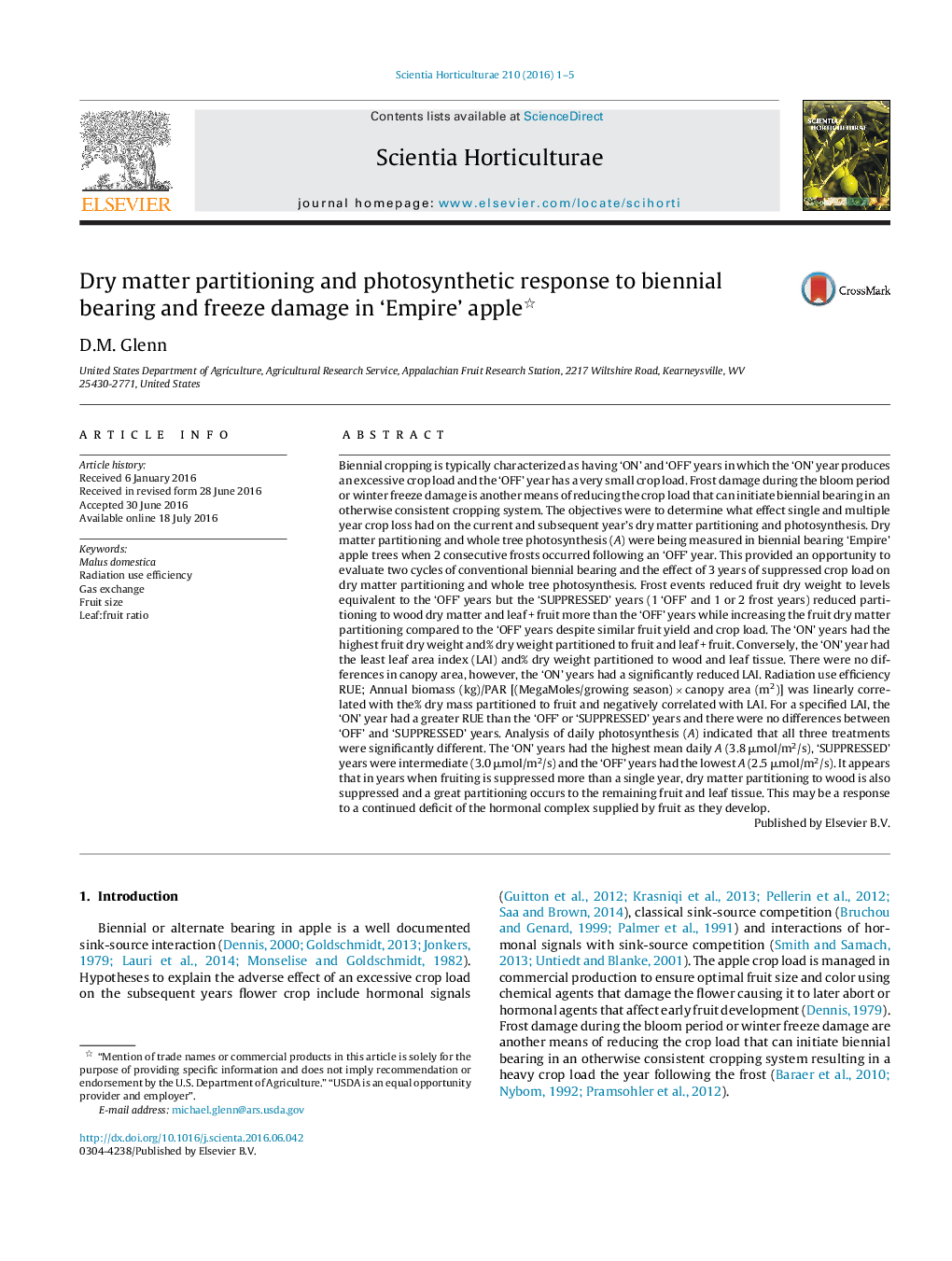| Article ID | Journal | Published Year | Pages | File Type |
|---|---|---|---|---|
| 4565906 | Scientia Horticulturae | 2016 | 5 Pages |
•Biennial cropping is typically characterized as having ‘ON’ and ‘OFF’ years.•Frost damage can reduce the crop load and initiate biennial bearing.•The study measured the effect single and multiple year crop loss.•Dry matter partitioning to wood is suppressed by multiple ‘OFF’ years.•Partitioning to fruit and leaf tissue is increased by multiple ‘OFF’ years.
Biennial cropping is typically characterized as having ‘ON’ and ‘OFF’ years in which the ‘ON’ year produces an excessive crop load and the ‘OFF’ year has a very small crop load. Frost damage during the bloom period or winter freeze damage is another means of reducing the crop load that can initiate biennial bearing in an otherwise consistent cropping system. The objectives were to determine what effect single and multiple year crop loss had on the current and subsequent year’s dry matter partitioning and photosynthesis. Dry matter partitioning and whole tree photosynthesis (A) were being measured in biennial bearing ‘Empire’ apple trees when 2 consecutive frosts occurred following an ‘OFF’ year. This provided an opportunity to evaluate two cycles of conventional biennial bearing and the effect of 3 years of suppressed crop load on dry matter partitioning and whole tree photosynthesis. Frost events reduced fruit dry weight to levels equivalent to the ‘OFF’ years but the ‘SUPPRESSED’ years (1 ‘OFF’ and 1 or 2 frost years) reduced partitioning to wood dry matter and leaf + fruit more than the ‘OFF’ years while increasing the fruit dry matter partitioning compared to the ‘OFF’ years despite similar fruit yield and crop load. The ‘ON’ years had the highest fruit dry weight and% dry weight partitioned to fruit and leaf + fruit. Conversely, the ‘ON’ year had the least leaf area index (LAI) and% dry weight partitioned to wood and leaf tissue. There were no differences in canopy area, however, the ‘ON’ years had a significantly reduced LAI. Radiation use efficiency RUE; Annual biomass (kg)/PAR [(MegaMoles/growing season) × canopy area (m2)] was linearly correlated with the% dry mass partitioned to fruit and negatively correlated with LAI. For a specified LAI, the ‘ON’ year had a greater RUE than the ‘OFF’ or ‘SUPPRESSED’ years and there were no differences between ‘OFF’ and ‘SUPPRESSED’ years. Analysis of daily photosynthesis (A) indicated that all three treatments were significantly different. The ‘ON’ years had the highest mean daily A (3.8 μmol/m2/s), ‘SUPPRESSED’ years were intermediate (3.0 μmol/m2/s) and the ‘OFF’ years had the lowest A (2.5 μmol/m2/s). It appears that in years when fruiting is suppressed more than a single year, dry matter partitioning to wood is also suppressed and a great partitioning occurs to the remaining fruit and leaf tissue. This may be a response to a continued deficit of the hormonal complex supplied by fruit as they develop.
